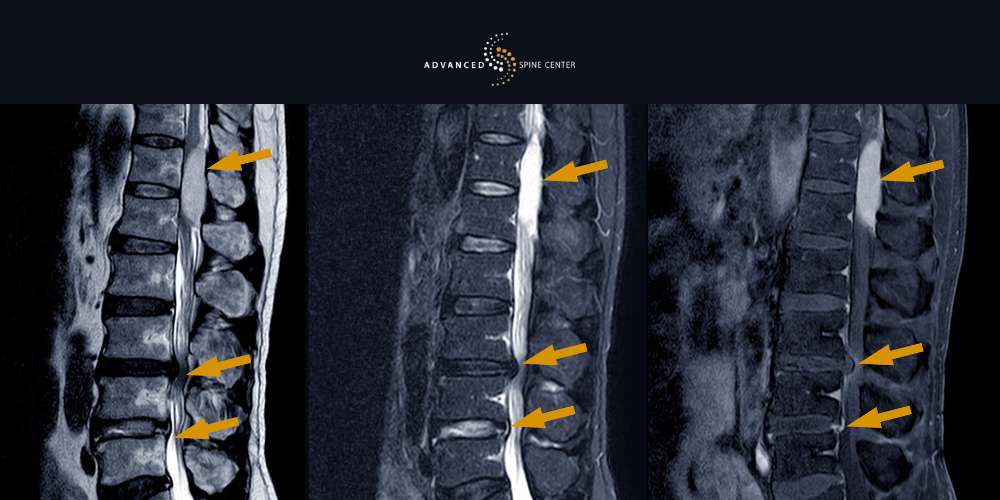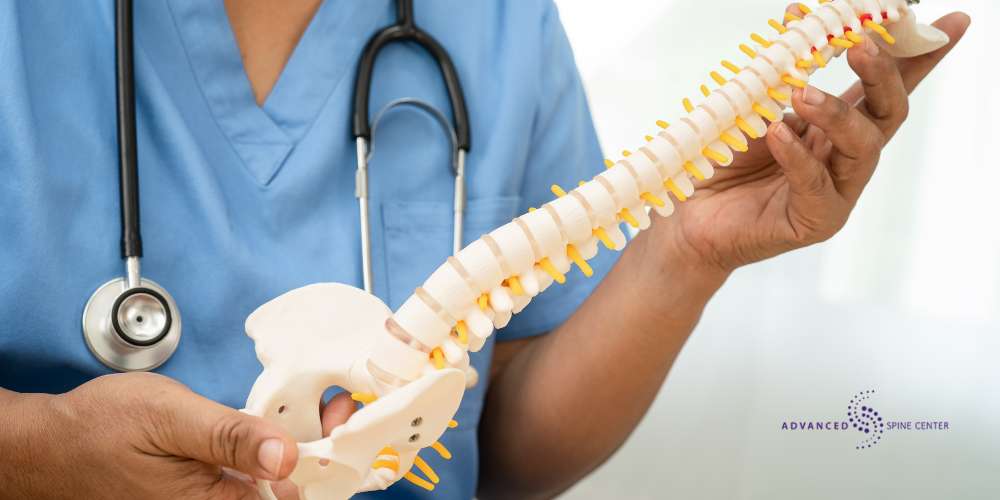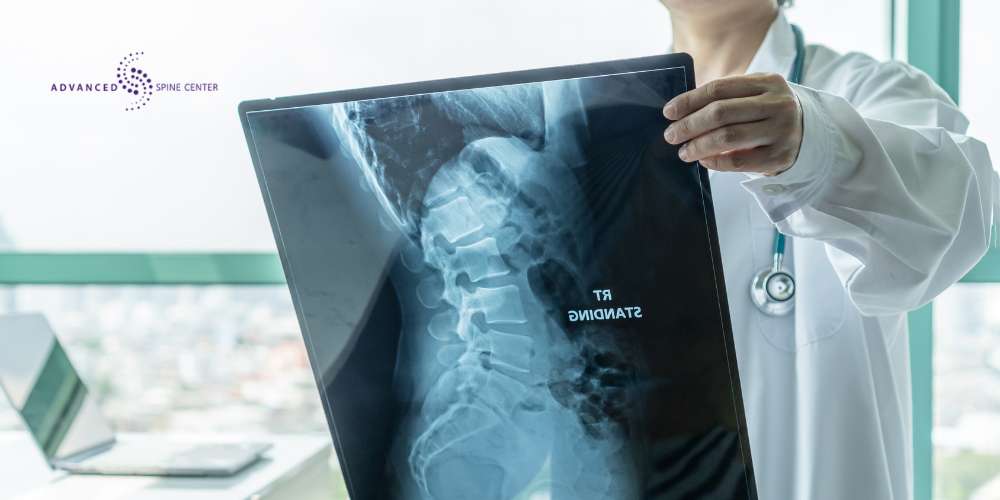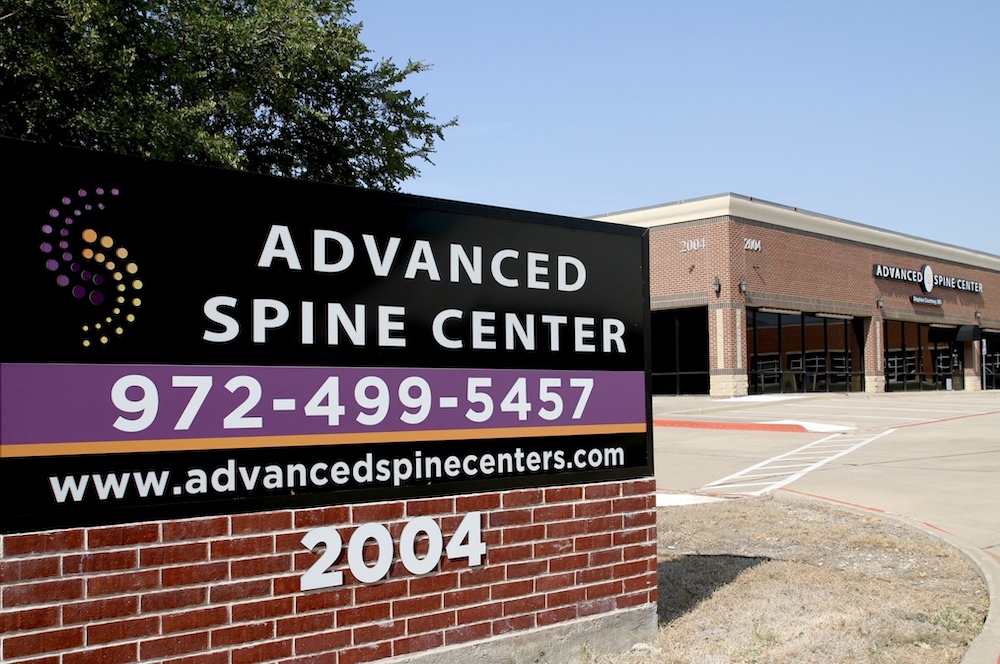Specialties

If you’re struggling with persistent neck pain, leg weakness, or sharp discomfort radiating through your back and limbs, you may be experiencing symptoms of foraminal stenosis. At Advanced Spine Center, we offer foraminal stenosis treatment in Plano, TX, for individuals experiencing nerve compression due to foraminal narrowing in the cervical, thoracic, or lumbar spine.
Whether your condition involves herniated discs, bone spurs, or degenerative disc disease, our team, led by Dr. Stephen Courtney, uses advanced diagnostic tools like magnetic resonance imaging and options such as physical therapy, epidural steroid injections, and minimally invasive surgical techniques to reduce pain and relieve pressure on the spinal nerve roots.
Don’t let chronic pain or spinal instability affect your quality of life. Call Advanced Spine Center at (972) 499-5457 or complete our online form to schedule an evaluation and learn more about treating foraminal stenosis.
What is Foraminal Stenosis?
Foraminal stenosis is a condition where the openings between the bones in your spinal column, called the intervertebral foramen, become narrowed. These openings are important because they allow spinal nerve roots to exit the spinal column and travel to other parts of the body. When this space becomes tight, it can press on the spinal nerves, causing a pinched nerve, also known as nerve root compression.
This condition can occur in different regions along the spinal cord, including the cervical spine, thoracic spine, and lumbar spine. It can result in neck pain, back pain, muscle weakness, or leg pain, depending on which nerves are affected.
Foraminal stenosis is a type of spinal stenosis and may develop due to bone spurs, herniated discs, or degeneration of the soft tissues around the spinal canal. When foraminal narrowing leads to persistent or severe pain, it may require specialized care such as foraminal stenosis treatment to relieve pressure on the affected nerves.
Bilateral Foraminal Stenosis
Bilateral foraminal stenosis is a condition where the openings on both sides of the spinal cord, known as the neural foramen, become narrowed, leading to pressure on the spinal nerve roots. This type of foraminal stenosis can occur in the cervical, thoracic, or lumbar spine, and often results in symptoms that affect both sides of the body.
Depending on the location, individuals may experience neck pain, back pain, leg weakness, or tingling in the arms or legs. In the lumbar spine, bilateral narrowing can also cause significant leg pain or difficulty standing for long periods.
Common causes include bone spurs, herniated discs, and the breakdown of soft tissues in the spinal cord. Because the condition impacts nerves on both sides, symptoms can be more intense and harder to ignore.
Treatment may involve a combination of conservative treatments like physical therapy and nonsteroidal anti-inflammatory drugs, or more advanced options such as epidural injections or minimally invasive procedures designed to relieve pressure on the spinal nerves.
Is Foraminal Stenosis the Same as Spinal Stenosis?
Foraminal stenosis and a condition called spinal stenosis are closely related, but they are not the same. Spinal stenosis is a broad term that refers to the narrowing of spaces within the spine, which can put pressure on the spinal cord or spinal nerves. Foraminal stenosis, on the other hand, is a specific type of spinal stenosis that affects the neural foramen, the small passageways where spinal nerve roots exit the spine.
While both conditions can cause nerve compression, chronic pain, and muscle weakness, foraminal stenosis targets a more precise location along the spinal column. It can occur in the cervical, thoracic, or lumbar spine, leading to symptoms such as neck pain, leg pain, or severe pain in the lower back.
Understanding the difference is important when choosing the right foraminal stenosis treatment, since targeted care is often needed to relieve pain and address the exact cause of nerve root compression. To learn more about spinal stenosis treatments in Plano, TX, contact Advanced Spine Center today to schedule a consultation.
Types of Foraminal Stenosis

Foraminal stenosis can affect different regions of the spine, and the location of the narrowing often influences both the symptoms and the foraminal stenosis treatment. Compression in the cervical, thoracic, or lumbar spine can impact different sets of spinal nerves, leading to a wide range of issues such as neck pain, leg pain, or muscle weakness.
Since nerve root compression presents differently depending on where the neural foramen is affected, recognizing the specific type of foraminal stenosis is an important step in selecting the most effective treatment approach.
Cervical Foraminal Stenosis
Cervical foraminal stenosis occurs when the openings in the cervical spine become narrowed and compress the nearby spinal nerves. This narrowing often results from bone spurs, herniated discs, or degenerative disc disease, all of which can crowd the neural foramen and lead to nerve compression.
When cervical foraminal stenosis occurs, it can cause symptoms such as neck pain, stiffness, tingling or numbness in the shoulders, arms, or hands, and, in some cases, muscle weakness. In more advanced cases, it may affect coordination or interfere with bowel or bladder control.
Lumbar Foraminal Stenosis
Lumbar foraminal stenosis occurs when the openings in the lower part of the spine begin to narrow and compress the spinal nerve roots. This condition often causes lower back pain, leg pain, muscle weakness, and numbness that can worsen with standing or walking.
This condition often occurs as a result of age-related changes, such as the development of bone spurs, disc herniation, or thickening of soft tissues around the spinal canal. When nerve compression becomes severe, it can interfere with movement and reduce quality of life.
Thoracic Foraminal Stenosis
Thoracic foraminal stenosis is less common than cervical or lumbar forms but can still lead to significant discomfort when the neural foramen in the thoracic spine becomes narrowed. This narrowing can compress the spinal nerves, resulting in symptoms such as mid-back pain, muscle weakness, or tingling that may wrap around the chest or abdomen.
The condition is often caused by bone spurs, degenerative disc disease, or herniated discs that press against the nerve roots in the thoracic region. Because the thoracic spine is more rigid and stable, thoracic foraminal stenosis may not be diagnosed as quickly, and symptoms can be mistaken for other conditions.
Foraminal Stenosis Symptoms

Symptoms of foraminal stenosis can vary depending on the location and severity of the nerve compression, but they often interfere with daily movement and comfort. Many people report chronic pain, muscle weakness, numbness, or a pinched nerve sensation that can affect different parts of the body.
These symptoms develop as the space in the neural foramen narrows, putting pressure on the spinal nerve roots. Whether the condition is mild or has progressed to severe foraminal stenosis, recognizing the signs early can help guide effective foraminal stenosis treatment and improve long-term outcomes.
Cervical Foraminal Stenosis Symptoms
Cervical foraminal stenosis symptoms often begin with neck pain that may spread to the shoulders, arms, or hands. People may also experience tingling, numbness, or a burning sensation in these areas due to nerve root compression in the cervical spine. In some cases, symptoms can include muscle weakness that affects grip strength or coordination.
As the narrowing of the neural foramen worsens, daily activities like turning the head, lifting objects, or even writing can become difficult. In more serious situations, cervical foraminal stenosis may also lead to problems with balance or changes in bowel or bladder control, especially if the spinal cord becomes involved.
Lumbar Foraminal Stenosis Symptoms
Lumbar foraminal stenosis symptoms normally begin with lower back pain that may radiate into the buttocks, thighs, or legs. This discomfort is often caused by nerve root compression in the lumbar spine, where the neural foramen has become narrowed.
Muscle weakness in the legs or feet is also common, especially in more advanced cases. Some individuals experience relief when sitting or leaning forward, as this position can temporarily reduce pressure on the spinal nerves. In severe cases, lumbar foraminal stenosis can also affect mobility and balance, making it difficult to perform routine activities.
Thoracic Foraminal Stenosis Symptoms
Thoracic foraminal stenosis symptoms can be harder to recognize since the thoracic spine is less flexible and less commonly affected than other areas. When symptoms do appear, they often include mid-back pain that may wrap around the ribs or chest. This pain is usually the result of nerve root compression in the neural foramen of the thoracic spine.
Because these symptoms can mimic other health issues, proper diagnosis using magnetic resonance imaging and a thorough review of your medical history is important. Identifying thoracic foraminal stenosis symptoms early can lead to faster pain relief and a more targeted approach to foraminal stenosis treatment.
What Causes Foraminal Stenosis?
Foraminal stenosis is most often caused by age-related changes in the spinal column that lead to narrowing of the neural foramen. One of the most common causes is degenerative disc disease, in which the discs between the vertebrae lose height and hydration over time, reducing the space for the spinal nerves.
Other frequent causes include bone spurs, which form as the spine tries to stabilize itself, and herniated discs, which bulge into the neural foramen and press against the nerve roots. Additional factors that can lead to foraminal narrowing include scar tissue, previous spine surgery, spinal injuries, and thickening of the soft tissues surrounding the spine. In rare cases, tumors or cysts may also block the openings.
These changes can occur in the cervical, thoracic, or lumbar spine. When they compress the spinal nerves, the result is often chronic pain, muscle weakness, and severe stenosis symptoms that may require treatment.
What is Considered Severe Foraminal Stenosis?
Severe foraminal stenosis refers to an advanced stage of foraminal narrowing where the space within the neural foramen becomes so restricted that it significantly compresses the spinal nerves. This level of compression often leads to constant or worsening symptoms, such as chronic pain, muscle weakness, numbness, or a burning sensation, which may affect the arms, legs, or torso, depending on whether the cervical, thoracic, or lumbar spine is involved.
People with severe foraminal stenosis may find it difficult to walk, stand for long periods, or perform everyday tasks. In some cases, it can also affect bowel or bladder control. Diagnostic tools, such as magnetic resonance imaging, are used to confirm the severity of the condition.
When conservative treatment is no longer effective, a minimally invasive procedure may be recommended to relieve pressure on the spinal nerve roots and prevent further damage.
Diagnosing Foraminal Stenosis in Plano, TX

When a patient shows signs of foraminal stenosis, such as neck pain, leg pain, muscle weakness, or tingling in the arms or legs, the first step is a thorough evaluation. This includes reviewing the patient’s medical history and asking detailed questions about symptoms, such as when they started, what triggers them, and how they affect daily activities.
A physical exam helps identify areas of nerve root compression and checks for signs like reduced reflexes or limited range of motion. Imaging is a key part of confirming the diagnosis. Tests like magnetic resonance imaging (MRI) or CT scans can reveal foraminal narrowing, herniated discs, or bone spurs that press on the spinal nerves. These diagnostic tests also help rule out other spine conditions and guide decisions on the most effective foraminal stenosis treatment plan.
Grading the Severity of Foraminal Stenosis
The severity of foraminal stenosis is graded based on how much the neural foramen has narrowed and how much pressure is being placed on the spinal nerve roots. Radiologists assess this using imaging results, especially magnetic resonance imaging, which provides detailed views of the spinal column and surrounding structures.
Mild foraminal stenosis may show slight narrowing with minimal nerve contact and often causes little or no noticeable symptoms. Moderate stenosis indicates more narrowing and may result in chronic pain, muscle weakness, or tingling sensations. Severe foraminal stenosis involves significant narrowing with clear nerve compression, often leading to severe pain, reduced mobility, and in some cases, problems with bowel or bladder control.
Grading helps determine the right approach to treating foraminal stenosis, whether through conservative treatments, epidural injections, or minimally invasive procedures to relieve pressure on the affected nerves.
Foraminal Stenosis Treatment in Plano, TX
Many people living with foraminal stenosis struggle with ongoing symptoms that interfere with daily life, from neck pain and leg weakness to sharp, shooting discomfort caused by nerve root compression. At Advanced Spine Center in Plano, we focus on finding effective ways to reduce these symptoms and improve function.
Depending on the location and severity of the condition, foraminal stenosis treatment in Plano, TX, may involve a range of options designed to help relieve pressure on the spinal nerves and restore mobility. Each treatment plan is tailored to the individual, taking into account specific symptoms, imaging results, and overall health.
Conservative Treatments for Foraminal Stenosis
Conservative treatments are often the first step in managing foraminal stenosis, especially in cases that are mild to moderate. These non-surgical options focus on reducing inflammation, easing nerve root compression, and improving movement.
Physical therapy can strengthen the muscles that support the spinal column and improve posture, which may help reduce pressure on the spinal nerve roots. Nonsteroidal anti-inflammatory drugs are commonly used to reduce pain and swelling around the affected area.
In some cases, epidural steroid injections are recommended to deliver targeted relief directly to the site of foraminal narrowing. Lifestyle changes, such as modifying activities or using supportive devices, may also be suggested. While these approaches may not reverse the condition, they can often provide meaningful pain relief and delay or prevent the need for surgery.
Minimally Invasive Procedures
When conservative treatments no longer provide enough relief, minimally invasive surgery may be recommended to treat foraminal stenosis. These techniques are designed to relieve pressure on the spinal nerves by removing or reshaping tissue that is compressing the nerve roots, such as bone spurs, herniated discs, or thickened soft tissues. Because the incisions are smaller than those used in traditional spine surgery, there is typically less damage to surrounding tissue, reduced scarring, and a shorter recovery period.
At Advanced Spine Center in Plano, we use advanced, minimally invasive surgical techniques to treat lumbar, thoracic, and cervical foraminal stenosis, tailored to each patient’s symptoms and imaging results. These options can be especially effective for patients with severe stenosis who need long-lasting pain relief and improved function without extensive downtime.
Surgical Intervention for Severe Cases of Foraminal Narrowing
In severe cases of foraminal narrowing, surgical intervention may be necessary. Surgery is aimed at relieving pressure on the spinal nerves by creating more space within the neural foramen. This may involve removing part of a bone spur, trimming a herniated disc, or stabilizing the vertebral body to address spinal instability.
The goal is to reduce nerve root compression and restore normal function. Depending on the location and underlying cause, the procedure may be performed using minimally invasive techniques that limit tissue damage and help speed up recovery.
Managing Chronic Pain from Foraminal Stenosis
Managing chronic pain from foraminal stenosis often requires a combination of treatments to reduce inflammation, ease nerve compression, and improve quality of life. When foraminal narrowing puts ongoing pressure on the spinal nerves, it can lead to persistent discomfort that affects daily activities, sleep, and mobility.
Treatment plans may include nonsteroidal anti-inflammatory drugs, epidural injections, and physical therapy to help strengthen the surrounding muscles and support the spinal column. In some cases, minimally invasive procedures may be considered if other methods do not provide enough pain relief. Lifestyle changes, such as avoiding movements that trigger symptoms or using supportive devices, can also make a difference.
Foraminal Stenosis FAQs
Is Foraminal Stenosis Painful?
Yes, foraminal stenosis can be painful, especially when the narrowing puts pressure on nearby spinal nerve roots. This pressure often leads to neck pain, back pain, leg pain, or tingling that may radiate into the arms or legs, depending on where the condition occurs in the spine.
What is the Treatment for Severe Foraminal Stenosis?
Treatment for severe foraminal stenosis often involves more advanced options when conservative treatments are no longer effective. This may include epidural steroid injections for temporary relief or a minimally invasive surgical procedure to relieve pressure on the compressed spinal nerves and restore mobility.
Is Foraminal Stenosis a Disability?
Foraminal stenosis can be considered a disability if it causes significant limitations in movement, chronic pain, or prevents someone from working or performing daily activities. In severe cases, symptoms like muscle weakness, nerve root compression, or loss of bowel or bladder control may qualify a person for disability benefits, depending on the medical documentation and impact on function.
Which is Worse, Spinal Stenosis or Foraminal Stenosis?
Spinal stenosis and foraminal stenosis both involve narrowing within the spine, but one is not always worse than the other. The impact depends on where the narrowing occurs and how much it affects the spinal cord or spinal nerves. Both conditions can lead to serious symptoms such as severe pain, muscle weakness, or loss of mobility if not properly treated.
What Happens if Foraminal Stenosis is Left Untreated?
If foraminal stenosis is left untreated, the pressure on the spinal nerve roots can worsen over time, leading to increased pain, numbness, and muscle weakness. In more serious cases, it may result in permanent nerve damage, difficulty walking, or problems with bowel or bladder control, especially if the compression becomes severe.
Contact the Advanced Spine Center for Foraminal Stenosis Treatments in Plano, TX

If you are struggling with chronic pain, muscle weakness, or other signs of foraminal stenosis, now is the time to take action. At Advanced Spine Center in Plano, we provide effective, customized care to help you find relief and get back to living without constant discomfort.
Our team is experienced in treating all forms of spinal stenosis, using both conservative treatments and minimally invasive procedures based on your needs. Call (972) 499-5457 today to schedule an appointment and learn more about your options.


